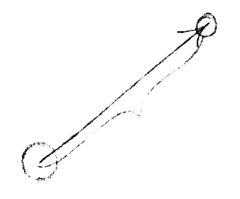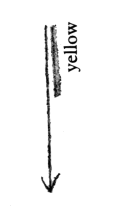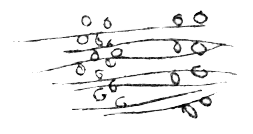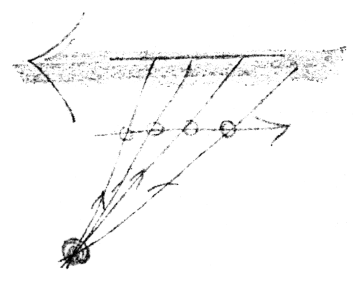The Origins of Natural Science
GA 326
Lecture VII
2 January 1923, Dornach
Continuing with yesterday's considerations concerning the inability of the scientific world conception to grasp the nature of man, we can say that in all domains of science something is missing that is also absent in the mathematical-mechanistic sphere. This sphere has been divorced from man, as if man were absent from the mathematical experience. This line of thought results in a tendency to also separate other processes in the world from man. This in its turn produces an inability to create a real bridge between man and world.
I shall discuss another consequence of this inability later on. Let us focus first of all on the basic reason why science has developed in this way. It was because we lost the power to experience inwardly something that is spoken of in Anthroposophy today and that in former times was perceived by a sort of instinctive clairvoyance. Scientific perception has lost the ability to see into man and grasp how he is composed of different elements.
Let us recall the anthroposophical idea that man is composed of four members—the physical body, the etheric body, the astral body and the I-organization. I need not go into detail about this formation, since you can find it all in my book Theosophy.59Rudolf Steiner, Theosophy (Spring Valley, NY: Anthroposophic Press, 1971), pp. 1–39. When we observe the physical body and consider the possibility of inward experiencing one's physical body—we should begin by asking: What do we experience in regard to it? We experience what I have frequently spoken about recently; namely, the right-left, up-down, and front-back directions. We experience motion, the change of place of one's own body. To some extent at least, we also experience weight in various degrees. But weight is experienced in a highly modified form. When these things were still experienced within our various members, we reflected on them a good deal; but in the scientific age, no one gives them any thought. Facts that are of monumental importance for a world comprehension are completely ignored. Take the following fact. Assume that you have to carry a person who weighs as much as you do. Imagine that you carry this person a certain distance. You will consciously experience his weight. Of course, as you walk this distance, you are carrying yourself as well. But you do not experience this in the same way. You carry your own weight through space, but you do not experience this. Awareness of one's own weight is something quite different. In old age, we are apt to say that we feel the weight of our limbs. To some extent this is connected with weight, because old age entails a certain disintegration of the organism. This in turn tears the individual members out of the inward experience and makes them independent—atomizes them, as it were—and in atomization they fall a prey to gravity. But we do not actually feel this at any given moment of our life, so this statement that we feel the weight of our limbs is really only a figure of speech. A more exact science might show that it is not purely figurative, but be that as it may, the experience of our weight does not impinge strongly on our consciousness.
This shows that we have an inherent need to obliterate certain effects that are unquestionably working within us. We obliterate them by means of opposite effects (“opposite” in the sense brought out by the analogy between man and the course of the year in my recent morning lectures.60Rudolf Steiner, Man and the World of Stars: The Spiritual Communion of Mankind (New York: Anthroposophic Press, 1963), pp. 141–172. Nevertheless, whether we are dealing with processes that can be experienced relatively clearly, such as the three dimensions or motion, or with less obvious ones such as those connected with weight, they are all processes that can be experienced in the physical body.
What was thus experienced in former times has since been completely divorced from man. This is most evident in the case of mathematics. The reason it is less obvious in other experiences of the physical body is that the corresponding processes in the body, such as weight or gravity, are completely extinguished for today's form of consciousness. These processes, however, were not always completely obliterated. Under the influence of the mood prevailing under the scientific world conception, people today no longer have any idea of how different man's inner awareness was in the past. True, he did not consciously carry his weight through space in former times. Instead, he had the feeling that along with this weight, there was a counterweight. When he learned something, as was the case with the neophytes in the mysteries, he learned to perceive how, while he always carried his own weight in and with himself, the counter-effect is constantly active in light. It can really be said that man felt that he had to thank the spiritual element indwelling the light for counteracting, within him, the soul-spirit element activity in gravity. In short, we can show in many ways that in older times there was no feeling that anything was completely divorced from man. Within himself, man experienced the processes and events as they occurred in nature. When he observed the fall of a stone, for example, in external nature (an event physically separated from him) he experienced the essence of movement. He experienced this by comparing it with what such a movement would be like in himself. When he saw a falling stone, he experienced something like this: “If I wanted to move in the same way, I would have to acquire a certain speed, and in a falling stone the speed differs from what I observe, for instance, in a slowly crawling creature.” He experienced the speed of the falling stone by applying his experience of movement to the observation of the falling stone. The processes of the external world that we study in physics today were in fact also viewed objectively by the man of former times, but he gained his knowledge with the aid of his own experiences in order to rediscover in the external world the processes going on within himself.
Until the beginning of the Fifteenth Century, all the conceptions of physics were pervaded by something of which one can say that it brought even the physical activities of objects close to the inner life of man. Man experienced them in unison with nature. But with the onset of the Fifteenth Century begins the divorce of the observation of such processes from man. Along with it came the severance of mathematics, a way of thinking which from then on was combined with all science. The inner experience in the physical body was totally lost. What can be termed the inner physics of man was lost. External physics was divorced from man, along with mathematics. The progress thereby achieved consisted in the objectifying of the physical. What is physical can be looked at in two ways. Staying with the example of the falling stone, it can be traced with external vision.  It can also be brought together with the experience of the speed that would have to be achieved if one wanted to run as fast as the stone falls. This produces comprehension that goes through the whole man, not one related only to visual perception.
It can also be brought together with the experience of the speed that would have to be achieved if one wanted to run as fast as the stone falls. This produces comprehension that goes through the whole man, not one related only to visual perception.
To see what happened to the older world view at the dawn of the Fifteenth Century, let us look at a man in whom the transition can be observed particularly well; namely, Galileo.61Galileo Galilei: Pisa 1564–1642 Arcetri by Florence. Discovered isochromism in pendulum, hydrostatic scales, laws of free fall, law of inertia. Numerous astronomical inventions with self-constructed telescope. An Inquisition trial resulted in a banning of the Copernican world system. See Riddles of Philosophy, The Spiritual Guidance of Man, and Laurenz Muellner's speech, “Die Bedeutung Galilei's fuer die Philosophie,” Vienna 1894. (Reprinted in Anthroposophie, 1933/34:29).
His Sermons de Motu Gravium (About the Effects of Gravity) contain the results of his investigations in Pisa. They first only circulated in manuscript copies; first edition: 1854. The final version is in the Discorsi e Dimenstrazioni Mathematiche Intomo a Due Nuove Scieme, published 1638 in Leyden. Also see L. Muellner's speech. Galileo is in a sense the discoverer of the laws governing falling objects. Galileo's main aim was to determine the distance traveled in the first second by a falling body. The older world view placed the visual observation of the falling stone side by side with the inward experience of the speed needed to run at an equal pace. The inner experience was placed alongside that of the falling stone. Galileo also observed the falling stone, but he did not compare it with the inward experience. Instead, he measured the distance traveled by the stone in the first second of its fall. Since the stone falls with increasing speed, Galileo also measured the following segments of its path. He did not align this with any inward experience, but with an externally measured process that had nothing to do with man, a process that was completely divorced from man. Thus, in perception and knowledge, the physical was so completely removed from man that he was not aware that he had the physical inside him as well.
At that time, around the beginning of the Seventeenth Century, a number of thinkers who wanted to be progressive began to revolt against Aristotle,62Such opponents were Bacon, Bruno, Galilei. See Riddles of Philosophy and the speech of L. Muellner, p. 103. who throughout the Middle Ages had been considered the preeminent authority on science. If Aristotle's explanations of the falling stone (misunderstood in most cases today) are looked at soberly, we notice that when something is beheld in the world outside, he always points out how it would be if man himself were to undergo the same process. For him, it is not a matter of determining a given speed by measuring it, but to think of speed in such a way that it can be related to some human experience. Naturally, if you say you must achieve a particular speed, you feel that something alive, something filled with vigor, will be needed for you to do this. You feel a certain inner impetus, and the last thing you would assume is that something is pulling you in the direction you were heading. You would think that you were pushing, not that you were being pulled. This is why the force of attraction, gravity, begins to mean something only in the Seventeenth Century.
Man's idea about nature began to change radically; not just the law of falling bodies, but all the ideas of physics. Another example is the law of inertia, it is generally called. The very name reveals its origin within man. (There is a play on words here. The German term for inertia, Trägheit, really means laziness.) Inertia is something that can be inwardly felt but what has become of the law of inertia in physics under the influence of “Galileoism?” the physicist says: A body, or rather a point, on which no external influence is exercises, which is left to itself, moves through space with uniform velocity. This means that throughout all time-spans it travels the same distance in each second. If no external influence interferes, and the body has achieved a given speed per second, it travels the same distance in each succeeding second.

It is inert. Lacking an external influence, it continues on and on without change. All the physicist does is measure the distance per second, and a body is called inert if the velocity remains constant.
There was a time when one felt differently about this and asked: How is a moving body, traveling a constant distance per second, experienced? It could be experienced by remaining on one and the same condition without ever changing one's behavior. At most, this could only be an ideal for man. He can attain this ideal of inertia only to a very small degree. But if you look at what is called inertia in ordinary life, you see that it is pretty much like doing the same thing every second of your life.
From the Fifteenth Century on, the whole orientation of the human mind was led to such a point that we can fairly say that man forgot his own inward experience. This happens first with the inner experience of the physical organism—man forgets it. What Galileo thought out and applied to matters close to man, such as the law of inertia, was not applied in a wide context. And it was indeed merely thought out, even if Galileo was dealing with things that can be observed in nature.
We know how, by placing the sun in the center instead of the earth, and by letting the planets move in circles around the sun, and by calculating the position of a given planetary body in the heavens, Copernicus produced a new cosmic system in a physical sense. This was the picture that Copernicus drew of our planetary, our solar system. And it was a picture that certainly can be drawn. Yet, this picture did not make a radical turn toward the mathematical attitude that completely divorces the external world from man. Anyone reading Copernicus's text gets the impression that Copernicus still felt the following. In the complicated lines, by means of which the earlier astronomy tried to grasp the solar system, it not only summed up the optical locations of the planets; it also had a feeling for what would be experienced if one stood amid these movements of the planets. In former ages people had a very clear idea of the epicycles the planets were thought to describe. In all this there was still a certain amount of human feeling. Just as you can understand the position of, let us say, an arm when you are painting a picture of a person because you can feel what it is like to be in such a position, so there was something alive in tracing the movement described by a planet around its fixed star. Indeed, even in Kepler's63Johannes Kepler: Weil der Stadt (Wuerttemberg) 1571–1630 Regensburg. Mathematician, physicist, astronomer, discoverer of the astronomical telescope. Astronomer and mathematician to three emperors. Persecuted as a Protestant. Totally exhausted through his life misery, he died prematurely at the “Reichstag” at Regensburg, where he hoped to secure his subsistence. To calculate his three laws of the motion of the planets he used the observation data of Tycho Brahe, whose follower he was at the court of Prague. On the other hand, the Copernican planetary system was the starting point for the finding of the three laws of the planets. Kepler was the first who tried to interpret the motion of the planetary orbit and moved the center of force to the sun. See The Spiritual Guidance of Man and, about the three planetary laws Das Verhaeltnis der Verschiedenen Naturwissenschaftlichen Gebiete zur Astronomie (Dornach: Rudolf Steiner Verlag, 1981), GA Bibl. Nr. 323. case—perhaps especially in his case—there is still something of a human element in his calculating the orbits described by the planets.
Now Newton applies Galileo's abstracted principle to the heavenly bodies, adopting something like the Copernican view and conceiving things somewhat as follows: A central body, let us say a sun, attracts a planet in such a way that this force of attraction decreases in proportion to the square of the distance. It becomes smaller and smaller in proportion to the square, but increases in proportion to the mass of the bodies. If the attracting body has a greater mass, the force of attraction is porportionately greater.

If the distance is greater, the force of attraction decreases, but always in such a way that if the distance is twice as great, the attraction is four times less; if it is three times as great, nine times less, and so forth. Pure measuring is instilled into the picture, which, again, is conceived as completely abstracted from man. This was not yet so with Copernicus and Kepler but with Newton, a so-called “objective” something is excogitated and there is no longer any experience, it is all mere excogitation. Lines are drawn in the direction in which one looks and forces are, as it were, imagined into them, since what one sees is not force; the force has to be dreamed up. Naturally, one says “thought up” as long as one believes in the whole business; but when one no longer has faith in it, one says, “dreamed up.”
Thus we can say that through Newton the whole abstracted physical mode of conception becomes generalized so far that is applied to the whole universe. In short, the aim is to completely forget all experience within man's physical body; to objectify what was formerly pictured as closely related to the experience of the physical body; to view it in outer space independent of the physical corporeality, although this space had first been torn out of the body experience; and to find ways to speak of space without even thinking about the human being. Through separation from the physical body, through separation of nature's phenomena from man's experience in the physical body, modern physics arises. It comes into existence along with this separation of certain processes of nature from self-experience within the physical human body (yellow in sketch). Self experience is forgotten (red in Fig. 1)

By permeating all external phenomena with abstract mathematics, this kind of physics could not longer understand man. What had been separated from man could not be reconnected. In short, there emerges a total inability to bring science back to man.
In physical respects you do not notice this quite so much; but you do notice it if you ask: What about man's self-experience in the etheric body, in this subtle organism? Man experiences quite a bit in it. But this was separated from man even earlier and more radically. This abstraction, however, was not as successful as in physics. Let us go back to a scientist of the first Christian centuries, the physician Galen.64Galen: Pergamon, Asia Minor 129 A.D.–199 Rome. Physician and philosopher. Studies in Pergamon and travel for study to Corinth, Smyrna, and Alexandria. Personal physician of Emperor Marcus Aurelius. His one hundred and fifty medical texts with fifteen commentaries were the basis for future medicine and pharmacology. One hundred twenty-five texts concerning philosophy, mathematics, and jurisprudence. Looking at what lived in external nature and following the traditions of his time, Galen distinguished four elements—earth, water, air and fire (we would say warmth.) We see these if we look at nature. But, looking inward and focusing on the self-experience of the etheric body,65Rudolf Steiner, A Road to Self Knowledge: The Threshold of the Spiritual World (London: Rudolf Steiner Press, 1975), pp. 19–27,100–106. one asks: How do I experience these elements, the solid, the watery, the airy and the fiery in myself? Then, in those times the answer was: I experience them with my etheric body. One experienced it as inwardly felt movements of the fluids; the earth as “black gall,” the watery as “phlegm,” the airy as “pneuma” (what is taken in through the breathing process,) and warmth as “blood.” In the fluids, in what circulates in the human organism, the same thing was experienced as what was observed externally. Just as the movement of the falling stone was accompanied by an experience in the physical body, so the elements were experienced in inward processes. The metabolic process, where (so it was thought) gall, phlegm, and blood work into each other, was felt as the inner experience of one's own body, but a form of inward experience to which corresponded the external processes occurring between air, water, fire and earth.
| Warmth | -Blood | -Ego Organization | |
| Air | -Pneuma | -Astral Body | |
| Water | -Phlegm | -Etheric Body | -Chemistry |
| Earth | -Black Gall | -Physical body | -Physics |
Here, however, we did not succeed in completely forgetting all inner life and still satisfying external observation. In the case of a falling body, one could measure something; for example, the distance traveled in the first second. One arrived at a “law of inertia” by thinking of moving points that do not alter their condition of movement but maintain their speed. By attempting to eject from the inward experience something that the ancients strongly felt to be a specific inner experience; namely, the four elements, one was able to forget the inner content but one could not find in the external world any measuring system. Therefore the attempt to objectify what related to these matters, as was done in physics, remained basically unsuccessful to this day. Chemistry could have become a science that would rank alongside physics, if it had been possible to take as much of the etheric body into the external world as was accomplished in the physical body. In chemistry, however, unlike physics, we speak to this day of something rather undefined and vague, when referring to its laws.66This is confirmed in chemical textbooks. They speak of chemistry as “a primarily empirical science.” In its laws one cannot come to mathematically definite values but to approximate numbers, whose limits are defined in tabular form. Therefore authors of chemical subject books need to add limiting explanations, such as “usually is valid,” or “generally one can say.” Chemical laws are mostly derived from physical laws, as for instance in the main theses of thermodynamics. It is thought unscientific to think otherwise than mechanically. Literature: H. Remy, Lehrbuch der Anorganischen Chemie, 7th ed., 2 vols. (Leipzig: 1954), Volume I, pages 14–23, 37, 50, 71–73. What was done with physics in regard to the physical body was in fact the aim of chemistry in regard to the etheric body. Chemistry states that if substances combine chemically, and in doing so can completely alter their properties, something is naturally happening.

But if one wants to go beyond this conception, which is certainly the simplest and most convenient, one really does not know much about this process. Water consists of hydrogen and oxygen; the two must be conceived as mixed together in the water somehow but no inwardly experiencable concept can be formed of this. It is commonly explained in a very external way: hydrogen consists of atoms (or molecules if you will) and so does oxygen. These intermingle, collide, and cling to one another, and so forth. This means that, although the inner experience was forgotten, one did not find oneself in the same position as in physics, where one could measure (and increasingly physics became a matter of measuring, counting and weighing.) Instead, one could only hypothesize the inner process. In a certain respect, it has remained this way in chemistry to this day, because what is pictured as the inner nature of chemical processes is basically only something read into them by thought.

Chemistry will attain the level of physics only when with full insight into these matters, we can again relate chemistry with man, though not, of course, with the direct experience possessed by the old instinctive clairvoyance. We will only succeed in this when we gain enough insight into physics to be able to consolidate our isolated fragments of knowledge into a world conception and bring our thoughts concerning the individual phenomena into connection with man. What happens on one side, when we forget all inner experience and concentrate on measuring externals (thus remaining stuck in the so-called “objective”) takes its revenge on the other side. It is easy enough to say that inertia is expressed by the movement of a point that travels the same distance in each succeeding second. But there is no such point. This uniform movement occurs nowhere in the domain of human observation. A moving object is always part of some relationship, and its velocity is hampered here or there. In short, what could be described as inert mass,67See Georg Unger, Vom Bilden Physicalischer Begriffe, Volume 1, pages 41–49 and 57. or could be reduced to the law of inertia, does not exist. If we speak of movement and cannot return to the living inner accompanying experience of it, if we cannot relate the velocity of a falling body to the way we ourselves would experience this movement, then we must indeed say that we are entirely outside the movement and must orient ourselves by the external world. If I observe a moving body (see Fig. 7) and if these are its successive positions, I must somehow perceive that this body moves. If behind it there is a stationary wall, I follow the direction of movements and tell myself that the body moves on in that direction. But what is necessary in addition is that from my own position (dark circle) I guide this observation, in other words, become aware of an inward experience. If I completely leave out the human being and orient myself only out there, then, regardless of whether the object moves or remains stationary, while the wall moves, the result will be the same. I shall no longer be able to distinguish whether the body moves in one or the wall behind it in the opposite direction. I can basically make all the calculations under either one or the other assumption.

I lose the ability to understand a movement inwardly if I do not partake of it with my own experience. This applies, if I may say so, to many other aspects of physics. Having excluded the participating experience, I am prevented from building any kind of bridge to the objective process. If I myself am running, I certainly cannot claim that it is a matter of indifference whether I run or the ground beneath me moves in the opposite direction. But if I am watching another person moving over a given area, it makes no difference for merely external observation whether he is running or the ground beneath him is moving in the opposite direction. Our present age has actually reached the point, where we experience, if I may put it this way, the world spirit's revenge for our making everything physical abstract.
Newton was still quite certain that he could assume absolute movements, but now we can see numerous scientists trying to establish the fact that movement, the knowledge of movement, has been lost along with the inner experience of it. Such is the essence of the Theory of Relativity,68See Footnote 40. which is trying to pull the ground from under Newtonism. This theory of relativity is a natural historical result. It cannot help but exist today. We will not progress beyond it if we remain with those ideas that have been completely separated from the human element. If we want to understand rest or motion, we must partake in the experience. If we do not do this, then even rest and motion are only relative to one another.

